History

 There are a number of different kinds of governments, and people disagree on which is the best. Personally, I think that any government that takes away the freedoms of its people is destined to fail. Communism is a “political theory derived from Karl Marx, advocating class war and leading to a society in which all property is publicly owned, and each person works and is paid according to their abilities and needs.” Communism is also, known as Marxism, which is defined as “the political and economic theories of Karl Marx and Friedrich Engels, later developed by their followers to form the basis for the theory and practice of communism.” I don’t think most people know the real meaning of Marxism or Communism, or, for that matter, Socialism, which is “a political and economic theory of social organization which advocates that the means of production, distribution, and exchange should be owned or regulated by the community as a whole.” If people knew what these types of governments are really like, they would fight to keep them out of their countries. The problem is that people think the government will take care of them, and that they will benefit from the work of others. It never works that way. everyone in these situations gets poorer, except for the government.
There are a number of different kinds of governments, and people disagree on which is the best. Personally, I think that any government that takes away the freedoms of its people is destined to fail. Communism is a “political theory derived from Karl Marx, advocating class war and leading to a society in which all property is publicly owned, and each person works and is paid according to their abilities and needs.” Communism is also, known as Marxism, which is defined as “the political and economic theories of Karl Marx and Friedrich Engels, later developed by their followers to form the basis for the theory and practice of communism.” I don’t think most people know the real meaning of Marxism or Communism, or, for that matter, Socialism, which is “a political and economic theory of social organization which advocates that the means of production, distribution, and exchange should be owned or regulated by the community as a whole.” If people knew what these types of governments are really like, they would fight to keep them out of their countries. The problem is that people think the government will take care of them, and that they will benefit from the work of others. It never works that way. everyone in these situations gets poorer, except for the government.
The Union of Soviet Socialist Republics (USSR) was established in post-revolutionary Russia, on December 30, 1922. It combined Russia, Belorussia, Ukraine and the Transcaucasian Federation (which was divided in 1936 into the Georgian, Azerbaijan and Armenian republics). The new nation was also known as the Soviet Union. It was the successor to the Russian Empire and the first country in the world to be based on Marxist socialism. The rest of the world was rather stunned that this kind of regie actually existed, because it took away so many freedoms and personal property, and the people had no choice.
Because Russia was reeling from the Russian Revolution of 1917 and subsequent three-year Russian Civil War, the Bolshevik Party under Vladimir Lenin dominated the soviet forces. A coalition of workers’ and soldiers’ committees called for the establishment of a socialist state in the former Russian Empire. It was from there that the USSR was formed, and after that, all levels of government were controlled by the Communist Party, and the party’s Politburo, with its increasingly powerful general secretary, who effectively ruled the country. Everything, from Soviet industry was owned and managed by the state, and agricultural land was immediately confiscated and divided into state-run collective farms.
Over the coming decades, the Russian-dominated Soviet Union grew into one of the world’s most powerful and influential states. It eventually encompassed 15 republics…Russia, Ukraine, Georgia, Belorussia, Uzbekistan, Armenia, Azerbaijan, Kazakhstan, Kyrgyzstan, Moldova, Turkmenistan, Tajikistan, Latvia, Lithuania and Estonia. 
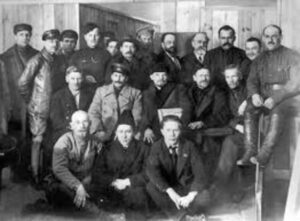 The USSR, as many knew it must, eventually failed because you can’t place people into a slave state without eventual rebellion. In 1991, the Soviet Union was dissolved following the collapse of its communist government. Communism, Marxism, and Socialism simply won’t work in the long run. If a nation wants growth and prosperity, they must have capitalism, so that the people have the incentive to be entrepreneurs, inventors, scientists, and so many other occupations in which discovery is made. Without incentive, people will simply quit.
The USSR, as many knew it must, eventually failed because you can’t place people into a slave state without eventual rebellion. In 1991, the Soviet Union was dissolved following the collapse of its communist government. Communism, Marxism, and Socialism simply won’t work in the long run. If a nation wants growth and prosperity, they must have capitalism, so that the people have the incentive to be entrepreneurs, inventors, scientists, and so many other occupations in which discovery is made. Without incentive, people will simply quit.
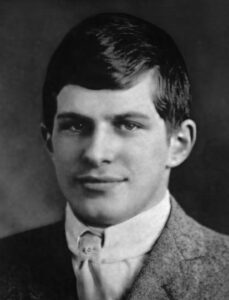
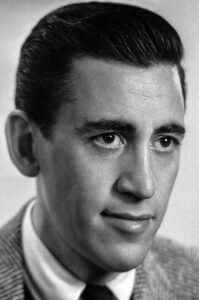 They say that genius can be the closest thing to crazy, but I don’t really know how true that is. Sometimes I think that when a person is a genius, people drive them crazy. It’s the novelty of the thing, I suppose. People find out that the genius has a super high IQ, and they all seem to want something from them. Many people don’t really care about the genius as a person, just about how they might be able to make money off of them somehow. Not every inventor is a genius, but some of them are, as are some mathematicians, doctors, teachers, writers, and many other people too.
They say that genius can be the closest thing to crazy, but I don’t really know how true that is. Sometimes I think that when a person is a genius, people drive them crazy. It’s the novelty of the thing, I suppose. People find out that the genius has a super high IQ, and they all seem to want something from them. Many people don’t really care about the genius as a person, just about how they might be able to make money off of them somehow. Not every inventor is a genius, but some of them are, as are some mathematicians, doctors, teachers, writers, and many other people too.
Sometimes the demands placed on these geniuses gets to be so heavy, that they might just snap. I don’t mean that they might go insane, although some of them have. The thing that seems to happen most, however, is that they might just decide to disappear. Several geniuses have simply vanished,  including William Sidis (who graduated from Harvard at 16, only to go into hiding, going from city to city and job to job), JD Salinger (author of Catcher in the Rye, who left Manhattan in 1953 to live on a “90-acre compound” in Cornish, NH. He remained there until his death in 2010, at age 91, saying he loved to write, but publishing was a terrible invasion of his privacy), Ettore Majorana (a theoretical physicist was considered one of the most deeply brilliant men in the world by Enrico Fermi, creator of the first nuclear reactor. One day he drained his bank account and simply vanished), David Thorne (an architect received so much attention for his work on jazz giant Dave Brubeck’s house in 1954, that he changed his professional name in the ‘60s to Beverly Thorne, got an unlisted phone number, and didn’t “resurface” until the 1980s), and Nick Gill (who at 21, was the youngest-ever British chef to win a Michelin star. He seemed destined for a life of fame and fortune and was hailed as a culinary genius. One day he told his brother he was going to disappear, and to “please, not look for him,” never to be seen again).
including William Sidis (who graduated from Harvard at 16, only to go into hiding, going from city to city and job to job), JD Salinger (author of Catcher in the Rye, who left Manhattan in 1953 to live on a “90-acre compound” in Cornish, NH. He remained there until his death in 2010, at age 91, saying he loved to write, but publishing was a terrible invasion of his privacy), Ettore Majorana (a theoretical physicist was considered one of the most deeply brilliant men in the world by Enrico Fermi, creator of the first nuclear reactor. One day he drained his bank account and simply vanished), David Thorne (an architect received so much attention for his work on jazz giant Dave Brubeck’s house in 1954, that he changed his professional name in the ‘60s to Beverly Thorne, got an unlisted phone number, and didn’t “resurface” until the 1980s), and Nick Gill (who at 21, was the youngest-ever British chef to win a Michelin star. He seemed destined for a life of fame and fortune and was hailed as a culinary genius. One day he told his brother he was going to disappear, and to “please, not look for him,” never to be seen again).
It isn’t known, as to why these geniuses would decide that they no longer wanted to be a part of the world, nor 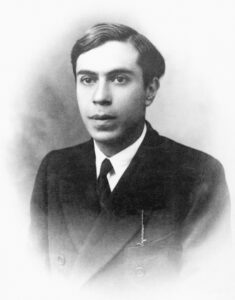
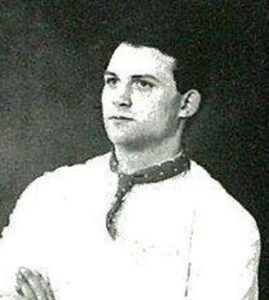 are they to only people to do this by any means. Nevertheless, they seem to have one thing in common, their genius skill or knowledge seemed to take over their whole life, and people wouldn’t leave them alone, but rather hounded them unmercifully. I think I can understand how that would be enough to make someone want to disappear, but most people don’t actually go so far as to take that step. It is a rather extreme step to take, and for all we know some of these might have been killed or committed suicide. The sad reality for these genius minds is that the fame and constant pressure of celebrity was too much for them, and they just checked out, because the burden of knowledge was just too much for them.
are they to only people to do this by any means. Nevertheless, they seem to have one thing in common, their genius skill or knowledge seemed to take over their whole life, and people wouldn’t leave them alone, but rather hounded them unmercifully. I think I can understand how that would be enough to make someone want to disappear, but most people don’t actually go so far as to take that step. It is a rather extreme step to take, and for all we know some of these might have been killed or committed suicide. The sad reality for these genius minds is that the fame and constant pressure of celebrity was too much for them, and they just checked out, because the burden of knowledge was just too much for them.
 For thousands of years, people have wanted to feel like they left a mark on this Earth…a way to say, “I was here.” Not everyone could be famous, and in fact most people aren’t famous, nor would they want to be. Still, they want to feel like their life mattered…like someone cared that they had lived. Many of us, in fact most people are not famous. They are just everyday people who go about their daily lives…working, raising families, going to school and church, and spending time with families. Their lives would not be thought of as spectacular. Still for most people, someone…somewhere cares that they existed. Nevertheless, in 100 years it’s quite likely that no one will even remember their name.
For thousands of years, people have wanted to feel like they left a mark on this Earth…a way to say, “I was here.” Not everyone could be famous, and in fact most people aren’t famous, nor would they want to be. Still, they want to feel like their life mattered…like someone cared that they had lived. Many of us, in fact most people are not famous. They are just everyday people who go about their daily lives…working, raising families, going to school and church, and spending time with families. Their lives would not be thought of as spectacular. Still for most people, someone…somewhere cares that they existed. Nevertheless, in 100 years it’s quite likely that no one will even remember their name.
These days that may be changing with sites like Ancestry.com, My Heritage, 23 and Me, and probably others, people find it easier to be “known” by the masses. Still, many people don’t even notice if a friend lands in Facebook Jail…until they get out and tell everyone. Really most of us just live our lives…day by day, expecting everything to be normal and no real excitement. With that in mind, some people found a new way to leave a  little piece of their lives in a safe place to be found by someone else, years later. In fact, it has become a big deal…called a “Time Capsule” but it isn’t new. There was a time capsule at the high school I graduated from, and its opening years later was documented by my niece, Liz Masterson, who graduated from there too, and now is a teacher there. There was also a time capsule in a local restaurant that was found when they did some remodeling many years later. Some time capsules are even older, such as the one found in 2015 in the Cairngorms National Park in Scotland. This one was a 121-year-old time capsule, and it was discovered by construction workers on a section of the Ruthven Road bridge.
little piece of their lives in a safe place to be found by someone else, years later. In fact, it has become a big deal…called a “Time Capsule” but it isn’t new. There was a time capsule at the high school I graduated from, and its opening years later was documented by my niece, Liz Masterson, who graduated from there too, and now is a teacher there. There was also a time capsule in a local restaurant that was found when they did some remodeling many years later. Some time capsules are even older, such as the one found in 2015 in the Cairngorms National Park in Scotland. This one was a 121-year-old time capsule, and it was discovered by construction workers on a section of the Ruthven Road bridge.
Time capsules can be any kind of container. They just need to be able to stand up to the environment they are placed in. A wooden box is ok in a place that won’t get wet, and most times people try to place things in such a place. The Cairngorms National Park capsule was a metal box, similar to a safe-deposit box at a bank. The excitement around the time capsule grew, and when it was opened, the items inside that were found included…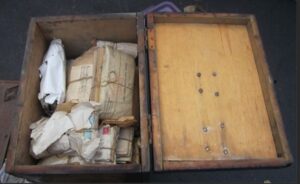 a bottle of whisky, a newspaper from 1894, a scroll, and some other items. As often happens, the items and the box itself were donated to the nearby Highland Folk Museum to be studied. As to the timeframe, it is believed that the time capsule was placed within the structure of the bridge when it was originally constructed at the end of the 19th century, so the 1894 newspaper wasn’t far off. Of course, unless there were specific names in the box, the people in the particular show of “I was here” will remain a mystery. Still, they will be remembered, even if we don’t know exactly who “they” were.
a bottle of whisky, a newspaper from 1894, a scroll, and some other items. As often happens, the items and the box itself were donated to the nearby Highland Folk Museum to be studied. As to the timeframe, it is believed that the time capsule was placed within the structure of the bridge when it was originally constructed at the end of the 19th century, so the 1894 newspaper wasn’t far off. Of course, unless there were specific names in the box, the people in the particular show of “I was here” will remain a mystery. Still, they will be remembered, even if we don’t know exactly who “they” were.

 Just outside the little village of Chatillon in Southern Belgium, on top of a tree covered hill, hidden from view, there was a “car cemetery” filled with cars that once belonged to the US servicemen stationed there. No one really knows how the soldiers came to obtain the cars exactly, especially since they were mostly American made cars…meaning they must have been shipped over to Belgium. So, the soldiers who were stationed in Belgium during World War II somehow had cars to drive to get around while they were serving over there.
Just outside the little village of Chatillon in Southern Belgium, on top of a tree covered hill, hidden from view, there was a “car cemetery” filled with cars that once belonged to the US servicemen stationed there. No one really knows how the soldiers came to obtain the cars exactly, especially since they were mostly American made cars…meaning they must have been shipped over to Belgium. So, the soldiers who were stationed in Belgium during World War II somehow had cars to drive to get around while they were serving over there.
Then, once the war was over, the soldiers returned to the United States. I suppose that bringing the vehicles over happened a few at a time, but shipping them back would be a massive undertaking, so it was decided to leave them behind. To me, it would seem like they should have given the cars away. At least that way, people in the area could have a car, when they might not have been able to afford one any other way. Nevertheless, that was not how it was done. The officers in charge decided to leave them in the country and parked them all up at the top of a hill, which was hidden from view. It was left up to the individual soldier whether or not they wanted to have their car shipped to them once they returned home, at their own expense. Not one of them decided to retrieve their car. These days the way things took place in the end, would have very likely cause an international uproar because they basically littered the landscape with junk cars. Of course, they weren’t junk at the time, and I suppose the people of the area could have taken the cars as abandoned. I’m not sure how they would have run when it was finally determined that they were abandoned, and maybe it was decided that it would cost too much. That may be the reason that none of the soldiers ever claimed their vehicles…a cost too heavy and no help in sight.
After many years, the forest was in the process of making very slow work of returning the cars to nature. The stories about the “Car Cemetery” persisted, and possibly complaints too. It was said that American-made cars had been brought by American and Canadian NATO troops to a mechanic in Châtillon. One by one, the cars were driven up a hill, parked, and somehow hidden from the outside world. Eventually, local people added their own old cars too. Possibly the mechanic was to keep them for the soldiers, but after France’s 1966 withdrawal from NATO, he was left “holding the bag” as it were, with hundreds of scrap cars that gradually became overgrown until a television documentary brought the “illegal dump” to light. Finally, the cars were removed and crushed in October 2010.
To date, some of the cars are said to still be there. At one point there was not one but four car graveyards 
 around the village of Chatillon with as many as 500 vehicles. The ones that remain today are only a fraction of the original number of cars. A lot of cars and their parts were stolen by the locals and international car collectors, so maybe some of them have been restored before they were completely lost. Either way, it was a very strange situation.
around the village of Chatillon with as many as 500 vehicles. The ones that remain today are only a fraction of the original number of cars. A lot of cars and their parts were stolen by the locals and international car collectors, so maybe some of them have been restored before they were completely lost. Either way, it was a very strange situation.

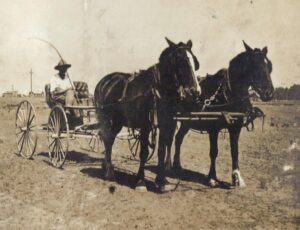 Road rage is a common expression these days. In fact, you would have to be living under a rock not to know what road rage is. Most of us think that road rage is something that has come about as there are more and more vehicles on the road; as well as the fact that so many people are so busy, and stress is an ever-present part of life. While I personally believe that road rage has really gotten out of hand, I suppose that it has actually taken centuries…yes, centuries to get there, but it really has gotten way out of control.
Road rage is a common expression these days. In fact, you would have to be living under a rock not to know what road rage is. Most of us think that road rage is something that has come about as there are more and more vehicles on the road; as well as the fact that so many people are so busy, and stress is an ever-present part of life. While I personally believe that road rage has really gotten out of hand, I suppose that it has actually taken centuries…yes, centuries to get there, but it really has gotten way out of control.
In fact, road rage didn’t even begin with the invention of the automobile. There are instances of “road rage” even as far back as the days of horses and chariots, as well as occurrences during the horse and buggy days, not to mention the days of bicycles. It seems that people have always argued over the right-of-way. The reality is that people have always argued over rights in general. For some people, when they get in the driver’s seat, many people check all sense of calmness at the entrance to the vehicle. These same people can’t seem to control their tempers and look beyond the mistake the other driver might have made, to notice that the offending driver might have been having a bad day.
Don’t get me wrong, I have been guilty of road rage too, and looking back I am pretty ashamed of myself for it. I have also been “guilty” of anti-road rage too, and I always walk away feeling awful. I far prefer to see the smile on the face of the offending person, who’s heart has been racing in anticipation of the screaming rage that is coming their way…the screaming rage that doesn’t come. Then, when they see the smile on my face telling them that all is well, and they aren’t going to get yelled at, their face floods with relief. I’m telling you, there is no better feeling behind the wheel than that.
In the instance I am referring to, I was at a traffic light waiting for my turn to go. The light changed to green, 
 and I prepared to go, when a car ran the red light. As she started into the intersection, her eyes were a big as saucers. It was my chance to change the situation. I smiled and waved her through the light. Shocked, she smiled back, and I can tell you that we both went to work that day feeling a lot better than we had just moments before. If only everybody just took a breath and smiled, instead of raging.
and I prepared to go, when a car ran the red light. As she started into the intersection, her eyes were a big as saucers. It was my chance to change the situation. I smiled and waved her through the light. Shocked, she smiled back, and I can tell you that we both went to work that day feeling a lot better than we had just moments before. If only everybody just took a breath and smiled, instead of raging.
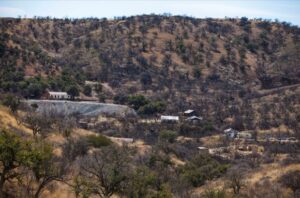
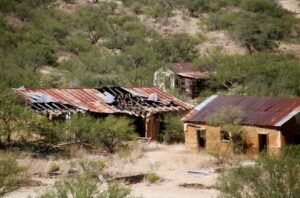 Lots of mining towns started out when someone discovered gold, silver, or some other precious metal. A few of them have continued to produce enough “treasure” to maintain and even rapidly grow a town. Others fizzled in a short time, or even a long time, but when the mines dried up, the towns went with them. Because of that, there are numerous ghost towns that dot the United States…and probably other nations too.
Lots of mining towns started out when someone discovered gold, silver, or some other precious metal. A few of them have continued to produce enough “treasure” to maintain and even rapidly grow a town. Others fizzled in a short time, or even a long time, but when the mines dried up, the towns went with them. Because of that, there are numerous ghost towns that dot the United States…and probably other nations too.
Ruby, Arizona is a ghost town in very near the Arizona-Mexico border. It is one of the best-preserved ghost towns in the state. In the 1700s, rich minerals were discovered there by the Spaniards, but they were not rich enough for their tastes, so only a limited amount of placer mining occurred before they moved on, leaving the area largely undisturbed for nearly a century, until two mining engineers, Chares Poston and Henry Ehrenberg,  revived the old Spanish placers in Montana Gulch in 1854. With the discovery of rich veins of gold and silver, which the Spaniards had somehow missed, came other prospectors looking for their own rich strike. While the area was rich in gold and silver, it also had Apache Indians, and they were…hostile, to say the least.
revived the old Spanish placers in Montana Gulch in 1854. With the discovery of rich veins of gold and silver, which the Spaniards had somehow missed, came other prospectors looking for their own rich strike. While the area was rich in gold and silver, it also had Apache Indians, and they were…hostile, to say the least.
Nevertheless, mining did proceed starting around 1877. Ruby, Arizona was founded as a mining town in Bear Valley, originally named Montana Camp. It was so named because the miners were mining at the foot of Montana Peak. The Montana mine produced gold, silver, lead, zinc, and copper…peaking in the mid-1930s. While never a large town, Ruby had a population of about 1,200 people. The post office was established on April 11, 1912, by the mining camp’s general store, Julius Andrews. When Andrews named the post office “Ruby,” after his wife, Lille B Ruby Andrews, and the mining camp became known as Ruby. The post office closed on May 31, 1941.
The town of Ruby has been through some wild times, and never was that more evident than the years between 1920 and 1922, when the town and the area surrounding Ruby was the scene of three double homicides known as the Ruby Murders. The largest manhunt in the history of the Southwest followed the crimes, and it included the first airplane ever used in an Arizona manhunt. The town’s most prosperous period was in the late 1920s 
 and 1930s, when the Eagle-Picher Mining Company operated the mine. They also upgraded the camp. The Montana mine was the leading lead and zinc producer in Arizona from 1934 to 1937. In 1936, it was third in silver production. Nevertheless, it seems, in mining anyway, that “all good things must come to an end” and so it was with the mine, which closed in 1940. By the end of 1941 Ruby was abandoned.
and 1930s, when the Eagle-Picher Mining Company operated the mine. They also upgraded the camp. The Montana mine was the leading lead and zinc producer in Arizona from 1934 to 1937. In 1936, it was third in silver production. Nevertheless, it seems, in mining anyway, that “all good things must come to an end” and so it was with the mine, which closed in 1940. By the end of 1941 Ruby was abandoned.
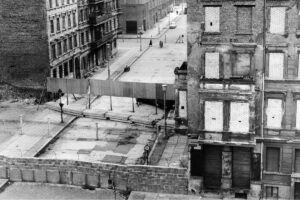
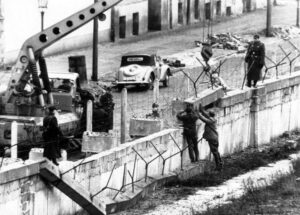 In August of 1961, virtually overnight, the Berlin appeared, separating East and West Berliners from each other. Streets, subway lines, bus lines, tramlines, canals, and rivers were divided. Family members, friends, lovers, schoolmates, work colleagues, and others were abruptly separated. For many, life was put on hold. That meant that families were instantly separated from each other, and there was nothing anyone could do about it. If a child was spending the night with a grandparent, they now had to stay there. If couples were separated, possibly due to jobs or something, they couldn’t get back together. Families who lived on opposite sides of town, couldn’t see each other. No recourse. All the families could do was stand beside the wall and talk to each other.
In August of 1961, virtually overnight, the Berlin appeared, separating East and West Berliners from each other. Streets, subway lines, bus lines, tramlines, canals, and rivers were divided. Family members, friends, lovers, schoolmates, work colleagues, and others were abruptly separated. For many, life was put on hold. That meant that families were instantly separated from each other, and there was nothing anyone could do about it. If a child was spending the night with a grandparent, they now had to stay there. If couples were separated, possibly due to jobs or something, they couldn’t get back together. Families who lived on opposite sides of town, couldn’t see each other. No recourse. All the families could do was stand beside the wall and talk to each other.
From the time of its construction, it was more than two years after before anyone was able to cross from one side of the wall to the other. In the meantime, children grew, children were born, people died. Some children and grandchildren never got to see their parents or grandparents again. The whole purpose of the Berlin Wall was to force the people in East Berlin to accept communism. The only way they “might be able” to stay alive was to comply. So, the citizens of East Berlin became virtual prisoners overnight. Their sentence was long, and they had no trial. They were simply locked up in their own city.
The “sentence” continued for more than two years, before anything changed. Then, finally, on December 20, 1963, nearly 4,000 West Berliners were allowed to cross into East Berlin to visit relatives. It was called a “one-day pass” and didn’t mean the end of the siege. Nevertheless, it was a moment of hope. The day was a result 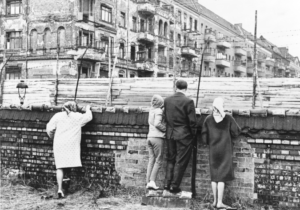
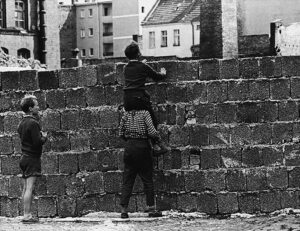 of an agreement reached between East and West Berlin. Eventually, over 170,000 passes were issued to West Berlin citizens, each pass allowing a one-day visit to communist East Berlin. Of course, there would be no passes for East German citizens to visit the west. The government knew they would not come back.
of an agreement reached between East and West Berlin. Eventually, over 170,000 passes were issued to West Berlin citizens, each pass allowing a one-day visit to communist East Berlin. Of course, there would be no passes for East German citizens to visit the west. The government knew they would not come back.
The day was marketed as a “wonderful government” doing some kind of a great thing. There were also moments of poignancy and propaganda. The reunions who were filled with tears, laughter, and other outpourings of emotions as mothers and fathers, sons and daughters finally met again. They were grateful, if only for a short time. The tensions of the Cold War were ever close by.
As people crossed through the checkpoints, loudspeakers in East Berlin greeted them. They were told that they were now in “the capital of the German Democratic Republic,” a political division that most West Germans refused to accept. The propaganda continued as each visitor was given a brochure that explained that the wall was built to “protect our borders against the hostile attacks of the imperialists.” They were told that decadent western culture, including “Western movies” and “gangster stories,” were flooding into East Germany before the wall sealed off such dangerous trends. The picture they were painting was of the East German government being the “saviors of the morality” of the people.
The West Berliners weren’t terribly happy either and many newspapers charged that the visitors charging that they were just pawns of East German government propaganda. It was said that the whole thing was a ploy to 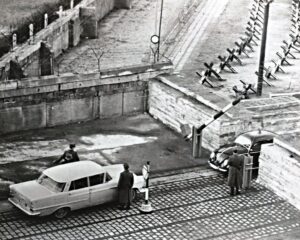
 gain West German acceptance of a permanent division of Germany. Whatever the case may be, the visitors felt that they had no choice to comply with the rules, because their hearts were being torn out by these separations. The separation continued until President Reagan called for the wall to be torn down in a speech in West Berlin on June 12, 1987…almost 26 years after it was built.
gain West German acceptance of a permanent division of Germany. Whatever the case may be, the visitors felt that they had no choice to comply with the rules, because their hearts were being torn out by these separations. The separation continued until President Reagan called for the wall to be torn down in a speech in West Berlin on June 12, 1987…almost 26 years after it was built.
 In what reality is an “invisible” army a thing…much less important? Well, the answer is…in World War II. During that war, in which battles were being fought against multiple enemy nations, of multiple fronts, the British needed a little unusual help with the different fronts. In actuality, no British Fourth Army ever took the field. That didn’t mean that they weren’t very effective in their work. but they existed as part of the deception plans Operation Cockade and the later Operation Fortitude North. During these operations, the Germans were encouraged to believe that a Fourth Army had been established with its headquarters in Edinburgh Castle, and that it was preparing to invade Norway. Britain’s “Fourth Army” was successful in drawing and keeping the German units away from the real invasion zone in Normandy. Then, in the subsequent ‘Fortitude South’ the Fourth Army with different units was presented as part of the fictitious First United States Army Group (FUSAG) in its threat to the Pas de Calais.
In what reality is an “invisible” army a thing…much less important? Well, the answer is…in World War II. During that war, in which battles were being fought against multiple enemy nations, of multiple fronts, the British needed a little unusual help with the different fronts. In actuality, no British Fourth Army ever took the field. That didn’t mean that they weren’t very effective in their work. but they existed as part of the deception plans Operation Cockade and the later Operation Fortitude North. During these operations, the Germans were encouraged to believe that a Fourth Army had been established with its headquarters in Edinburgh Castle, and that it was preparing to invade Norway. Britain’s “Fourth Army” was successful in drawing and keeping the German units away from the real invasion zone in Normandy. Then, in the subsequent ‘Fortitude South’ the Fourth Army with different units was presented as part of the fictitious First United States Army Group (FUSAG) in its threat to the Pas de Calais.
The Fourth Army was always a “fictitious field army.” It first came into being as part of the British Expeditionary Force during the World War I. It was actually formed on February 5, 1916, under the command of General Sir Henry Rawlinson. The plan was for this fictitious army to carry out the main British contribution to the Battle of 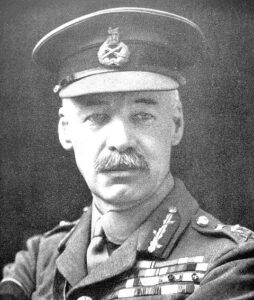 the Somme, but they quickly saw how effective a rumor could be in a war situation, and that is truly what this was. Basically, the word is sent out that a huge army is blocking a front that the enemy is trying to reach, or that they are planning to attack the enemy on a different front. So, the enemy decides to take another route…often a longer route, or in response to the rumored attack, the enemy sends it troops to the wrong place all together…only to find out they have been duped.
the Somme, but they quickly saw how effective a rumor could be in a war situation, and that is truly what this was. Basically, the word is sent out that a huge army is blocking a front that the enemy is trying to reach, or that they are planning to attack the enemy on a different front. So, the enemy decides to take another route…often a longer route, or in response to the rumored attack, the enemy sends it troops to the wrong place all together…only to find out they have been duped.
It must have been awful to take the troops into what is expected to be a battle, only to find out that they had been fooled. Imagine how that would make you look to your troops. The intel was completely false, and they fell for it. That must have made they feel very stupid on top of the fact that they wasted a lot of time on an imaginary enemy. While the Germans, in this case, looked incredibly stupid, it made the British Army look quite wise. Who would have thought that “make believe” could be such an effective weapon of warfare?

 When a country is fighting for recognition, one of the most important events is when other countries recognize your country as being an independent nation. It’s rather hard to conduct business with other nations, if you are viewed as a rouge or non-existent nation. That was the position the United States found themselves in right after the Declaration of Independence was adopted. Just because a country adopts its declaration of independence, doesn’t mean that it’s a done deal. That document can and has been the cause of major wars. The United States was no exception on the war end of that either. They fought long and hard to win that declared independence from Great Britain.
When a country is fighting for recognition, one of the most important events is when other countries recognize your country as being an independent nation. It’s rather hard to conduct business with other nations, if you are viewed as a rouge or non-existent nation. That was the position the United States found themselves in right after the Declaration of Independence was adopted. Just because a country adopts its declaration of independence, doesn’t mean that it’s a done deal. That document can and has been the cause of major wars. The United States was no exception on the war end of that either. They fought long and hard to win that declared independence from Great Britain.
Finally, the coveted recognition came when on December 17, 1777, the French foreign minister, Charles Gravier, count of Vergennes, officially acknowledged the United States as an independent nation. It came after news of the Continental Army’s overwhelming victory against the British General John Burgoyne at Saratoga. The victory gave Benjamin Franklin new leverage in his efforts to rally French support for the American rebels. Although the victory occurred in October, news did not reach France until December 4th. Remember that this mail system was worse than “snail mail” ever was. Messages had to be sent by ship across the ocean.
Benjamin Franklin had quickly mustered French support upon his arrival in December 1776. France’s humiliating loss of North America to the British in the Seven Years’ War made the French eager to see an American victory. Still, the French king worried about the consequences of backing “the rebels” openly. You can’t really blame him because an act like that could bring war to his own country. Still, he did back them in every other way. In May 1776, Louis XVI sent unofficial aid to the Continental forces and the playwright Pierre-Augustin Caron de Beaumarchais helped Franklin organize private assistance for the American cause.
Benjamin Franklin, who often wore a fur cap, captured the imagination of Parisians as an American man of nature and his well-known social charms stirred French passions for all things American. His personality made him the toast of Parisian society. He was very knowledgeable, and he had a way of enchanting groups of people 
 with his wide-ranging knowledge, social graces, and witty conversation. Nevertheless, he was not allowed to appear at court, so any legal assistance he might have offered in the defense of the United States, was never heard.
with his wide-ranging knowledge, social graces, and witty conversation. Nevertheless, he was not allowed to appear at court, so any legal assistance he might have offered in the defense of the United States, was never heard.
Finally, with the impressive and long-awaited rebel victory at Saratoga, Louis XVI was convinced that the American rebels had some hope of defeating the British empire. His enthusiasm for the victory paired with French Foreign Minister Gravier’s concern that the loss of Philadelphia to the British would lead Congress to surrender, gave Franklin two influential allies with two powerful, albeit opposing reasons for officially backing the American cause, and so it was that a formal treaty of alliance with the United States followed on February 6, 1778.
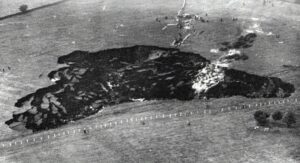 Underground mining always has the potential to become deadly. The people of New Cumnock in Ayrshire, Scotland know that all too well after a mine collapsed, trapped 120 miners underground in Knockshinnoch Castle colliery. The tragic event became known as the Knockshinnoch disaster and it occurred in September 1950 in the village of New Cumnock, Ayrshire, Scotland. The disaster began when a glaciated lake filled with liquid peat and moss flooded the pit workings, trapping more than a hundred miners underground. That set of a rescue effort that lasted for several days. Teams worked non-stop to reach the trapped men. They did finally reach the men, but by the time they were able to reach them, three days later, thirteen men had died.
Underground mining always has the potential to become deadly. The people of New Cumnock in Ayrshire, Scotland know that all too well after a mine collapsed, trapped 120 miners underground in Knockshinnoch Castle colliery. The tragic event became known as the Knockshinnoch disaster and it occurred in September 1950 in the village of New Cumnock, Ayrshire, Scotland. The disaster began when a glaciated lake filled with liquid peat and moss flooded the pit workings, trapping more than a hundred miners underground. That set of a rescue effort that lasted for several days. Teams worked non-stop to reach the trapped men. They did finally reach the men, but by the time they were able to reach them, three days later, thirteen men had died.
The men who survived were all found together 24 hours after the disaster began, and the thirteen men who died had been separated from the main group. They were missing for two more days before they were finally found. When the lake flooded, it released a field about the size of a football field into the mine. The resulting crater was about 300 feet by 200 feet and about 50 feet deep. The crater then sent liquid peat cascading into the mine, effectively blocking any exit for the men.
Thankfully, the mine owners had the forethought to install a phone in the mine, and the miners were able to phone for help. There was no way of reaching them, but the rescuers knew they were still alive, so the rescue efforts began in earnest. Rescue workers decided the easiest way to get them out was through an abandoned mine, next door. It took until 10:30pm local time for the rescuers to clear a passage through the unused mine and break through the final 30-foot wall of coal and rock that separated the two collieries. The rescue team,  made up of hundreds of miners, firefighters, and trained rescuers, worked all day to shore up the walls and ceiling of the old mine. Because the tunnels were so cramped, the workers had to work in shifts, using fans to disperse the gas known as firedamp which accumulates in sealed mines. Firedamp is not poisonous, but it reduces the amount of oxygen in the atmosphere making breathing difficult, not to mention the fact that it is also highly flammable. At one point, a rescue worker collapsed because the air was so foul. He had to be helped to the surface. The situation was really getting serious, and time was running out. The danger of explosion meant the rescuers had to use hand tools to cut through the rock delaying the rescue even more.
made up of hundreds of miners, firefighters, and trained rescuers, worked all day to shore up the walls and ceiling of the old mine. Because the tunnels were so cramped, the workers had to work in shifts, using fans to disperse the gas known as firedamp which accumulates in sealed mines. Firedamp is not poisonous, but it reduces the amount of oxygen in the atmosphere making breathing difficult, not to mention the fact that it is also highly flammable. At one point, a rescue worker collapsed because the air was so foul. He had to be helped to the surface. The situation was really getting serious, and time was running out. The danger of explosion meant the rescuers had to use hand tools to cut through the rock delaying the rescue even more.
Everyone was very focused on saving the trapped men. The volunteers were working above ground, filling the crater made by the landslide with haystacks, trees and other materials to prevent any further slippage. They knew that is more peat fell into the hole, it could have blocked what little ventilation the trapped men had. The buried miners kept in phone contact every 15 minutes or so. They were told how they could help the rescue operation by digging carefully and slowly, so as not to let in a sudden rush of foul air from the unused pit, because they had no oxygen masks to help them breathe.
Finally, the wall was breached. To let the family and friends of the trapped men know that their loved ones were safe, a siren was sounded on the surface. Immediately, huge crowds gathered near the pithead. The police linked arms to form a protective cordon around the exit. The last thing the men needed was a rush of people the minute they reached the surface. Shortly before midnight, rescuers began taking food and drink into the pit for the miners. They had been underground for so long without nutrition and hydration. While the rescuers 
 were now with the men, the process of bringing them out of the mine would not be a speedy one. The rescue tunnel was only wide enough for one man to crawl through at a time, and many are said to be weak, so they waited while they ate and drank some water, before beginning the trek out. The Area Manager of the National Coal Board David McArdle has described the rescue operation as the greatest in the history of Scottish mining.
were now with the men, the process of bringing them out of the mine would not be a speedy one. The rescue tunnel was only wide enough for one man to crawl through at a time, and many are said to be weak, so they waited while they ate and drank some water, before beginning the trek out. The Area Manager of the National Coal Board David McArdle has described the rescue operation as the greatest in the history of Scottish mining.

